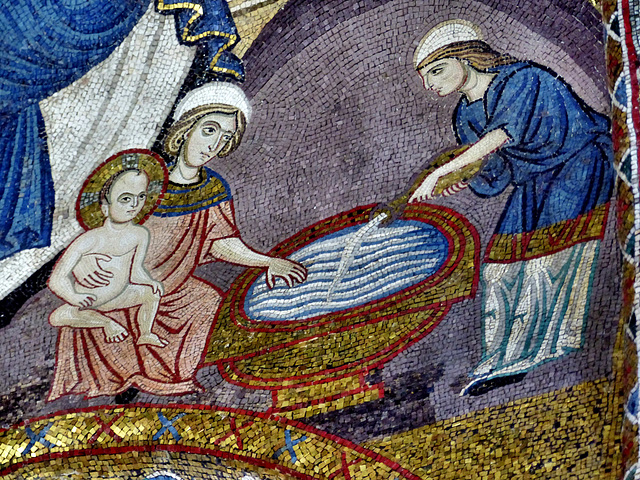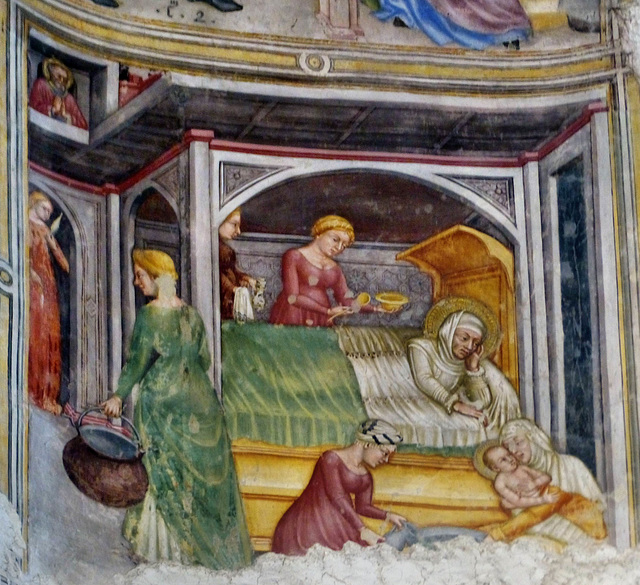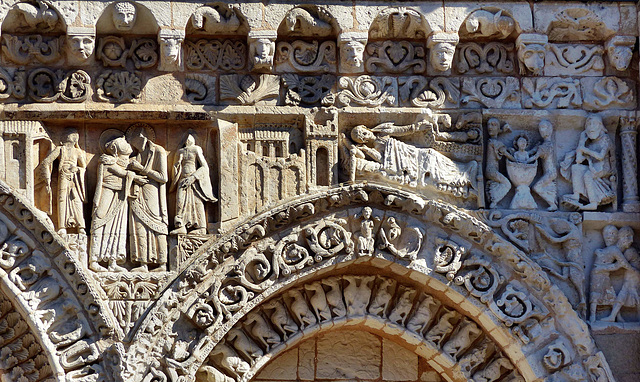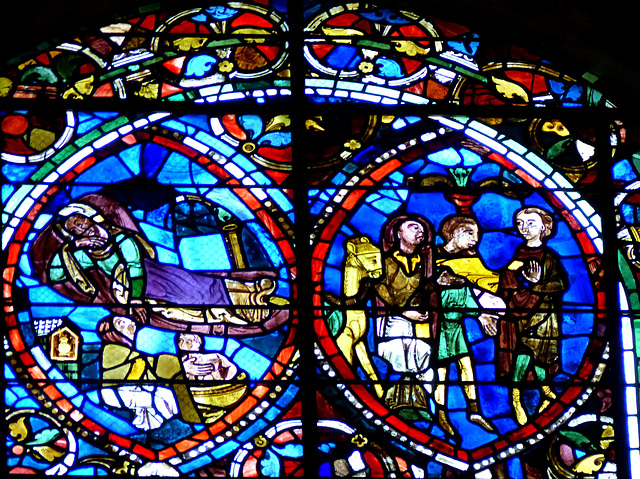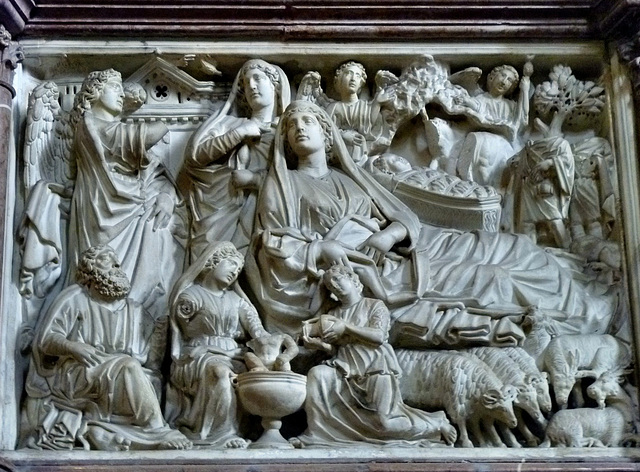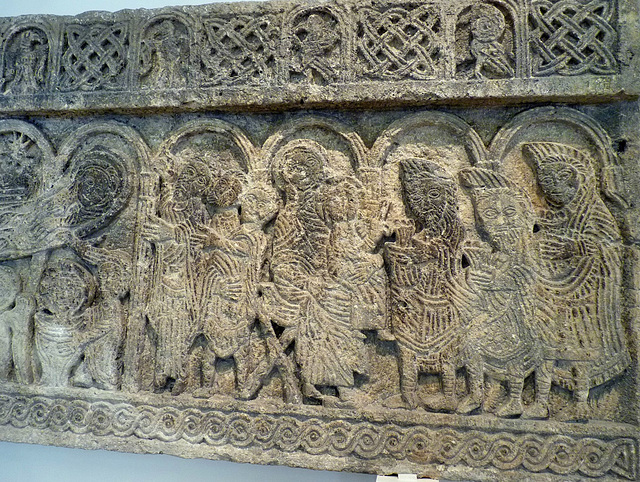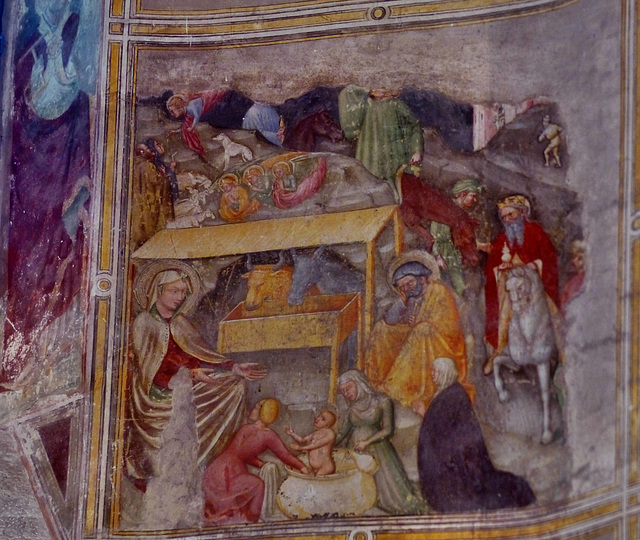
Jesus´ First Bath
The story of Jesus' First Bath, administered by two midwives, Salome and Zelomi, can be found in Jacob de Voragine's medieval best-seller, "The Golden Legend". It is in two of the early gospels that were considered apocryphal by the Council of Nicea, but remained in popular tradition.
Palermo - Martorana
Sicily, the largest Mediterranean island, has a long history, that starts around 8000 BC, but later there were Phoenician, Carthaginian, Greek and Roman periods. After the Roman Empire had fallen apart the Vandals tried to take over the island but failed. Finally, the Ostrogoths took possession.
Mid of the 6th century Sicily was conquered by troops of the Byzantine Empire. After the advent of Islam, Sicily got attacked by the Arab forces. Raids seeking loot continued until the mid-8th century.
A Muslim army was sent to the island in 827 but met with much resistance. So it took a century to conquer it and even later revolts constantly occurred
In 1038 the Byzantines invaded the island supported by Norman mercenaries, led by Roger. In 1072, after the siege of Palermo, most of Sicily was under Norman control. Roger´s son Roger II raised the status of the island to a kingdom in 1130. During this period, the Kingdom of Sicily was prosperous and powerful,
The court of Roger II became melting out of culture from Europe and the Middle East. This attracted scholars, scientists, artists, and artisans. Muslims, Jews, Greeks, Lombards, and Normans cooperated and created some extraordinary buildings.
In 1186 the last descendant of Roger, Constance of Sicily married Emperor Henry VI, the second son of Barbarossa. So the crown of Sicily was passed on to the Hohenstaufen Dynasty. Frederick II, the only son of Constance, was crowned King of Sicily at the age of four in 1198. He became "Stupor Mundi", one of the greatest and most cultured men of the Middle Ages.
Palermo, founded in 734 BC by the Phoenicians, became a possession of Carthage and later was part of the Roman Empire. From 831 to 1072 the city was under Arab rule. Following the Norman conquest, Palermo became the capital of a new Kingdom of Sicily and the capital of the Holy Roman Empire under Emperor Frederick II and King Conrad IV.
The Martorana, overlooking the Piazza Bellini, is located next to the "Chiesa de San Cataldo" (right). The church is as well known under the name "Santa Maria dell’Ammiraglio" and serves the Italo-Albanian parish of San Nicolò dei Greci, who officiate the liturgy according to the Byzantine Rite in the ancient Greek language.
The church was founded by (Syrian) George of Antioch, Ammiratus (Admiral) of Rogers II of Sicily, and built in 1143. Originally it was built over the layout of a Greek cross-in-square, but it has undergone numerous structural changes and additions throughout history. In 1435 the church was annexed to the Benedictine convent of Eloisia Martorana.
The interior of the church is breathtaking. During the iconoclasms the Byzantine Iconoclasms (730-850) Byzantine craftsmen and artists settled and worked in the west (eg Ravenna, Rome..). These mosaics were created by these artists.
"Jesus' First Bath", prepared by the midwives Salome and Zelomi, goes back to the "Gospel of Pseudo-Matthew" (aka "The Infancy Gospel of Matthew", was probably composed around 650. As some parts of it got included into the "Golden Legend", a medieval bestseller by Jacobus da Varagine (1230-1298), these stories were very popular.
Because of its richness, the church was visited, in the late 12th century, by the Arab traveller Ibn Jubayr, who left a detailed description of the church, defined as “the most beautiful monument in the world”.
Gubbio - San Francesco
A settlement existed here already in Bronze age, pre-Roman times the Umbrian people had a town here, named Ikuvium. After the Roman conquest the town gained importance. The Roman theatre here is the second-largest surviving in the world.
Gubbio became very powerful in the Middle Ages, when Gubbio sent 1000 knights to fight in the First Crusade. Later the city was engaged in wars against the surrounding towns of Umbria.
San Francesco is located in the lower town of Gubbio. The Gothic style church was built by 1256. St. Francis of Assisi, who was closely associated with Gubbio, supposedly was once housed in a room adjacent to the church.
San Francesco may be work of Benedictian monk Fra Bevignate, who engineered the aqueduct supplying water to the Fontana Maggiore in Perugia.
Ottaviano Nelli created the frescoes of the left apse 1410-1415.
"Mary in childbed", the two midwives prepare Jesus´ "First Bath".
Poitiers - Notre-Dame la Grande
Notre-Dame la Grande, a former collegiate church, was completed around 1150. This facade is a masterpiece of Romanesque art.
The church replaced an older one, known since the 9th century. The western facade is the result of an enlargement. In the first half of the 12th century, the older facade got removed - and two spans were added to the nave toward the west. The facade (sometimes called it a "frontage-screen") completed that enlargement. This facade is a brilliant example of the Romanesque "style poitevin". As the church went trough the Wars of Religions and the French Revolution many of the carvings are damaged.
Here is a more detailed view on that frieze.
Seen are the "Visitation", the "Nativity" and the "First Bath", watched by Joseph in his typical posture, his head is resting on his hand. Mary in childbed, ox and ass are seen over the crib. Baby Jesus smiles in the tub. The architecture of Bethlehem (?) reminds on fortified place. Note the two ("Greco-Roman") wrestlers just under Joseph and a very strange beast next to them.
Take a closer look to the piece of miniature architecture. For a while I thought, that this might stand for "Bethlehem", but it cannot. When it was created it was kind of very contemporary, as behind the protecting wall is a church - with a cross on the roof. Strange to see that next to the Nativity.
Poitiers - Cathedral
On the ruins of a older basilica begann, just next to the Baptistère Saint-Jean the construction of large Cathédrale Saint-Pierre in 1162. The building, the new the seat of the Archbishop of Poitiers, was greatly funded by Henry II of England (aka "Henri II Plantagenêt") and Eleanor of Aquitaine.
The construction started as usual in the east and was completed with the western facade end of the 13th century.
The cathedral is best known for the wonderful stained glass windows. The three windows around the choir date back to the 12th century and may be the oldest in France.
The windows of the eastern part of the nave may be some decades younger. so they will be created in the early 13th century.
I will upload some details of them.
I am not sure about this.
In case on the left is Mary in childbed, then below her is Jesus having his "First Bath". Supported by a midwife.
In case to the right is a camel/dromedary, then the three men may be the Magi. But where is the Star of Bethlehem?
Pisa - Baptistry
The construction of the "Battistero di San Giovanni" started in 1152 to replace an older baptistry. Since its completion in 1363 the transition from (Pisan) Romanesque to (Pisan) Gothic style was visible.
The baptistry was designed by Diotisalvi, who signed and dated the building ("1153"), similar to the "Chiesa del Santo Sepolcro" (previous uploads), he had designed some decades before.
The baptistry is about 54 m high, with a circumference of 107 m.
The pulpit of the baptistry is a masterpiece created in 1255-60 by Nicola Pisano, father of Giovanni Pisano. The pulpit's reliefs depict scenes from the life of Christ. Pisono´s works are strongly influenced by classical art and many see Pisano as a precursor of Italian Renaissance sculpture.
Here is the Nativity scene of the pulpit. There is the "Annunciation", the "Annunciation to the shepherds", Jesus in the manger, the "First Bath" - and in the center majestically recumbent Virgin Mary - just like an Etruscan tomb sculpture.
Zadar - Archaeological Museum
Zadar´s "Arheoloski Muzej", located next to the Roman Forum and St. Donatus holds an incredible collection of medieval artefacts.
Here are details of carved panels, that were once part of an altar screen in the Church of St. Demenica ("Sv. Nediljica") in Zadar. They are dated 1030/1040. Zadar had been part of the Byzantine Empire upto about 1000, when after raids of pirates, it sheltered under Venetian power. - Obviously the cultural influence from Byzanz was still very strong.
While on the left the shepherds watch the "First Bath" (under the Star of Bethlehem), Mary, seated on a folding chair, having Jesus on her knees, welcomes the Magi. The Magi resemble older carvings in Ravenna on the western side of the Adriatic Sea. Just like them, they wear phrygian caps. They are clearly "byzantine" in style.
Younger carvings mostly show the Magi wearing crowns. A political symbol, probably invented by a gifted spin doctor, bringing the Magi into an ancestral line with the medieval Kings.
Trogir - Cathedral of St. Lawrence
Trogir was founded by Greek colonists in the 3rd century BC. In Roman times this was an important harbour town. From the 9th century on Trogir was under Croatian rule and later part of the Byzantine empire. A diocese was established in the 11th century, in 1107 the Hungarian-Croatian King Coloman ("The Bookish", "Kálmán Könyves") granted the autonomy.
Saracen troops conquered Trogir in 1123 and demolished most of it. From 1420 upto 1797 Trogir belonged to the Republic of Venice. For a short while it belonged to the Napoleonic kingdom of Italy, but upto 1918 Trogir was part of the Habsburg Empire.
Trogir is more than 2000 years old. It grew under the influence of the ancient Greeks, the Romans, and the Venetians... Trogir's medieval core, surrounded by walls, comprises (about 10) churches, houses and palaces from the Romanesque, Gothic, Renaissance and Baroque periods.
Since 1997 the centre of Trogir is a "UNESCO World Heritage Site".
The Cathedral of St. Lawrence was erected from 1213 on the foundations of cathedral destroyed by the Saracens in 1123. Most of the work was done in the 13th century.
This cathedral is world wide known for Master Radovan´s portal seen here. The portal was carved by the local architect and sculptor Master Radovan (and his workshop). It was completed and signed by Radovan in 1240.
The tympamum over the main doors.
The grand drape has risen - and seen "on stage" is the Nativity.
Mary in childbed, Jesus behind her, watched by ox and ass. Below them, the midwives prepare the "First Bath", watched by Joseph. To the left are the shepherd (herding goats) - and to the right, the Magi approaching Bethlehem on horsebacks. There are many inscriptions. The main line is on the bottom, as it gives the title "post partum" (childbed), the author "Raduanum" and the date, as work was completed, when "Treguan from Florence was bishop of Trogir"
"Fundatur valve post partum virginis alme per Raduanum cunctis hac arte preclarum ut patet ex ipsis sculpturis et ex anagliphis anno milleno duceno bisque viceno presule Tuscano Floris ex urbe Treguano".
Roma - Santa Maria in Cosmedin
A Roman Temple existed here near an ancient food wholesale-market. Over the the centuries this temple was converted into a small Christian church. When during the iconoclastic riots in Byzantium many Greeks fled to Rome, Pope Adrian I in 772 commisioned the building of the church. Greek monks decorated the church, known as "Santa Maria in Schola Graeca" at that time.
I could not find any information about this fresco.
The icon "Jesus´ First Bath" can often be found on the "Apennine Peninsula" (now: "Italy") within the 12th century - and the Virgin has the very typical reclining posture, just like the Etruscian ladies, but the frescoe seems somehow younger.
Gubbio - San Francesco
A settlement existed here already in Bronze age, pre-Roman times the Umbrian people had a town here, named Ikuvium. After the Roman conquest the town gained importance. The Roman theatre here is the second-largest surviving in the world.
Gubbio became very powerful in the Middle Ages, when Gubbio sent 1000 knights to fight in the First Crusade. Later the city was engaged in wars against the surrounding towns of Umbria.
San Francesco is located in the lower town of Gubbio. The Gothic style church was built by 1256. St. Francis of Assisi, who was closely associated with Gubbio, supposedly was once housed in a room adjacent to the church.
San Francesco may be work of Benedictian monk Fra Bevignate, who engineered the aqueduct supplying water to the Fontana Maggiore in Perugia.
Ottaviano Nelli created the frescoes of the left apse 1410-1415.
A second Nativity scene here. Mary is now seated. Joseph waiting in his typical gestus. The midwives have prepared the "First Bath", watched by donkey and ox. Jesus is standing (!) in the tub. In the background the shepherds listen to the angels and to the right the Magi are approaching. The black lady on her knees is probably the donor of the frescoe.
Jump to top
RSS feed- Latest items - Subscribe to the latest items added to this album
- ipernity © 2007-2024
- Help & Contact
|
Club news
|
About ipernity
|
History |
ipernity Club & Prices |
Guide of good conduct
Donate | Group guidelines | Privacy policy | Terms of use | Statutes | In memoria -
Facebook
Twitter

